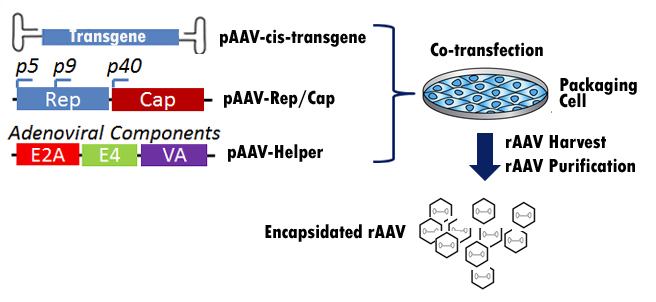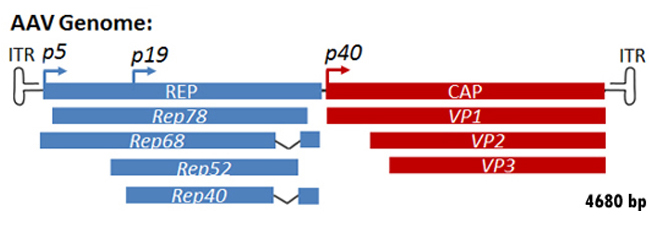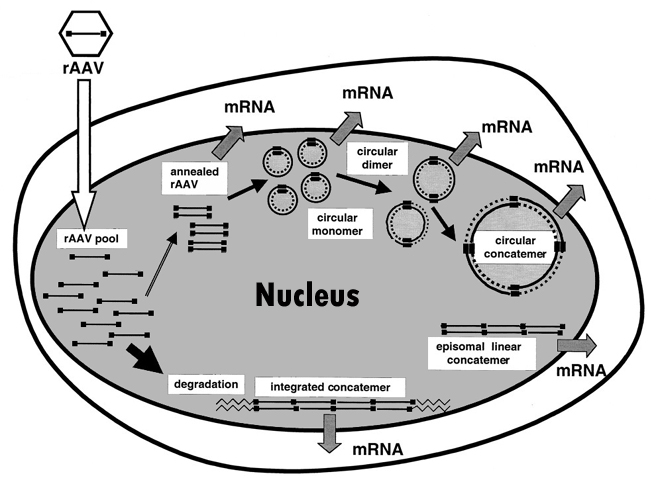What is adeno-associated virus (AAV)
The adeno-associated virus (AAV) is a small, icosahedral and nonenveloped virus
that belongs to Parvoviridae family. It was discovered in 1965 as a contaminant
of adenovirus (Ad) preparations and helper virus such as Adenovirus or Herpes
virus is usually required for a productive infection to occur. The wild AAV has
a linear single-stranded DNA genome of about 4.7 kb of either plus or minus
polarity. There are two ITRs flanking the two viral genes rep (replication) and
cap (capsid). The Rep gene encode four regulatory proteins:Rep78, Rep68, Rep52
and Rep40 on basis of molecular weight. The Cap gene encode three structural
proteins (VP1, VP2 and VP3) which assemble at a ratio of approximately 1:1:10,
to form a mature AAV particle which is approximately 22nm. The AAV2 DNA termini
consists of a 145 nucleotide-long inverted terminal repeat (ITR) that forms a
characteristic T-shaped hairpin structure, due to the multipalindromic nature of
its terminal 125 bases, which allows its fold on itself via complementary base
pairing , forming a secondary structure that provides a free 3' hydroxyl group
for the initiation of viral DNA replication via a self-priming
strand-displacement mechanism. AAV does not encode its own polymerase so its
replication process relies on host cell polymerase activities.
What is recombinant AAV (rAAV)?
Recombinant AAV is the artificial AAV which does not contain any AAV rep and
cap genes which encode viral replication and structural proteins, respectively.
rep and cap are replaced with a gene or construct of interest which is flanked
by the ITRs which contain all the cis-acting elements necessary for replication
and packaging. Though AAV possesses a 4.7 kb genome, efficient packaging of rAAV
can be performed with constructs ranging from 4.1 kb to 4.9 kb in size.
Is the rAAV safe?
The recombinant AAV (rAAV)
composed by several plasmids (cis plasmid, Helper plasmid, rep/Cap plasmid). Cis
plasmid and Helper do not share any regions of homology with the rep/cap-gene
containing plasmid , preventing the production of wild-type AAV-2 through
recombination system. To our knowledge AAV is NOT linked to any human disease.
Nevertheless it is recommended to fully understand the potential hazards of and
necessary precautions for laboratory use of rAAV vectors. Viruses could,
depending on your gene insert, be potentially hazardous. Similar vectors have
been approved for human gene therapy trials, attesting to their potential
ability to express genes in vivo. For these reasons, due caution must be
exercised in the production and handling of any recombinant viruses. Follow all
applicable guidelines for research involving recombinant DNA. Take appropriate
safety measures when producing or handling recombinant AAV, including working in
a biological safety cabinet and wearing protective laboratory coats, face
protection, and gloves.
What is the rAAV serotypes we offer?
Serotype is classified by the type of capsid structural proteins and
determines tissue specificity. Serotype 2 (AAV2) is the most well-studied
serotype. AAV2 has a broad range of tissue infectivity and is the most popular
serotype for research purposes. Serotype 5 (AAV5) and serotype 6 (AAV6) have
more specific tissue infectivity; AAV5 can infect cells in tissues including the
central nervous system, liver, and retina, whereas AAV6 can infect cells in
tissues including heart, muscle, and liver.
Currently we are offering rAAV production service for rAAV in serotype 1, 2,
3, 4, 5, 6, 7, 8, 9, DJ and DJ/8. We guarantee the final deliverable for
all the rAAV serotypes at >1E+13 VG/mL.
How much rAAV should be used for general animal experiments?
The amount rAAV used is highly dependent on the target tissue and route of
administration. For for mice the amount will be between 1E+10~1E+12 VG per
mouse (VG=vector genome, as measured by qPCR). However, the exact dose should be
determined empirically.
What is helper free rAAV?
Because AAV is a replication defective virus, its replication depend on other
virus such as adenovirus and herps virus. these virus also called helper virus.
Studies identified AAV only need some of Helper virus products (E1A and E1B,,
E2A, E4 and VA) which are provided in trans by another vector or by stably
expression cell line (Figure 1).

Figure 1. A cartoon showing how rAAV is packaged with a helper free system.
What are reps and caps?
They are replication proteins and capsid proteins encoded by rep and cap
genes respectively. Reps consist of rep 78, 68, 52 and 40. Reps involve the
replication of AAV. Caps have three proteins, VP1 (virion protein 1), VP2 and
VP3, with molecular weight of 87, 72 and 62 kDa respectively. These capsid
proteins assemble into a near-spherical protein shell of 60 subunits. Caps
determine the serotype of AAV.

Figure 2. A cartoon showing transcription and
translation of Rep and Cap genes to Rep and Cap proteins.
How to produce different serotype of recombinant AAV?
The most used method to produce different serotype of recombinant AAV is the
hybrid trans-complementing method in which the reps and ITR are derived from
AAV2; E2A, E4 ,VA from Adenovirus proteins provided by Helper plasmid, E1A and
E1B are stably expressed in 293 cells. Caps which give rise to the serotypes of
AAV are from different plasmids respectively.
What is the maximum insert size for recombinant AAV?
For conventional single-stranded rAAV, the packaging capacity is 4.5 kb from ITR
to ITR. For self-complementary (also known as double-stranded) rAAV, the
packaging capacity from ITR to ITR is around 2.3 kb.
Which serotype should I use in my experiment?
Below are some preliminary guidelines based on literatures.
AAV1: CNS, Eye, Heart, Lung, Skeletal muscle
AAV2: CNS, Eye
AAV5: CNS, Eye, Lung
AAV6: Adipose, Heart, Liver, Lung, Skeletal muscle
AAV8: Adipose, CNS, Eye, Liver, Skeletal muscle;
AAV9: Adipose, CNS, Eye, Heart, Liver, Lung, Skeletal muscle
AAV serotypes and their tropisms in vivo
|
Serotype |
CNS/Retina |
Heart |
Lung |
Liver |
Skeletal Muscle |
|
AAV1 |
X |
X |
X |
|
X |
|
AAV2 |
X |
|
|
X |
X |
|
AAV3 |
X |
X |
|
X |
|
|
AAV4 |
X |
X |
|
|
|
|
AAV5 |
X |
|
X |
|
|
|
AAV6 |
|
X |
X |
X |
X |
|
AAV7 |
X |
|
|
X |
X |
|
AAV8 |
X |
|
|
X |
X |
|
AAV9 |
X |
X |
X |
X |
X |
|
AAV10 |
X |
|
X |
|
|
Relative in vitro Infectivity of AAV Vectors:
|
Cell Line |
AAV-1 |
AAV-2 |
AAV-3 |
AAV-4 |
AAV-5 |
AAV-6 |
AAV-8 |
AAV-9 |
AAV-DJ |
AAV-DJ/8 |
|
Huh-7 |
13 |
100 |
2.5 |
0.0 |
0.1 |
10 |
0.7 |
0.0 |
500 |
0.2 |
|
HEK293 |
25 |
100 |
2.5 |
0.1 |
0.1 |
5 |
0.7 |
0.1 |
500 |
0.3 |
|
HeLa |
3 |
100 |
2.0 |
0.1 |
6.7 |
1 |
0.2 |
0.1 |
667 |
0.2 |
|
HepG2 |
3 |
100 |
16.7 |
0.3 |
1.7 |
5 |
0.3 |
ND |
1250 |
0.5 |
|
Hep1A |
20 |
100 |
0.2 |
1.0 |
0.1 |
1 |
0.2 |
0.0 |
400 |
0.1 |
|
911 |
17 |
100 |
11 |
0.2 |
0.1 |
17 |
0.1 |
ND |
500 |
0.0 |
|
CHO |
100 |
100 |
14 |
1.4 |
333 |
50 |
10 |
1.0 |
25000 |
5.0 |
|
COS |
33 |
100 |
33 |
3.3 |
5.0 |
14 |
2.0 |
0.5 |
500 |
0.3 |
|
MeWo |
10 |
100 |
20 |
0.3 |
6.7 |
10 |
1.0 |
0.2 |
2857 |
1.0 |
|
NIH3T3 |
10 |
100 |
2.9 |
2.9 |
0.3 |
10 |
0.3 |
ND |
500 |
0.1 |
|
A549 |
14 |
100 |
20 |
ND |
0.5 |
10 |
0.5 |
0.1 |
1000 |
0.1 |
|
HT1180 |
20 |
100 |
10 |
0.1 |
0.3 |
33 |
0.5 |
0.1 |
333 |
0.2 |
|
Monocytes |
1111 |
100 |
ND |
ND |
125 |
1429 |
ND |
ND |
100 |
ND |
|
Immature DC |
2500 |
100 |
ND |
ND |
222 |
2857 |
ND |
ND |
200 |
ND |
|
Mature DC |
2222 |
100 |
ND |
ND |
333 |
3333 |
ND |
ND |
100 |
ND |
Note: Infectivity rates normalized to AAV-2 = 100. ND = Not Determined
SignaGen provides AAV serotype test kit (cat # SL100886) for pilot serotype selection studies.
Keep in mind there is inconsistence of serotype selection studies be performed
in vitro and in vivo.
Why does rAAV infection mediate long-term and persistent transgene expression?
Unlike wild type AAV, recombinant adeno-associated virus (rAAV) vectors usually
does NOT
incorporate its transgene to host's genome. However rAAV is still capable
of mediating long-term gene expression following infection of host cells.
It was reported that in rodent muscle, the rAAV vector genomes persist in the nucleus in concatemeric
episomal forms which exist
predominantly as episomal monomeric and concatemeric circles. The episomal rAAV
genomes assimilate into chromatin with a typical nucleosomal pattern. The
persistence of the rAAV vector genomes and gene expression for years in quiescent
tissues suggests that a bona fide chromatin structure is important for episomal
maintenance and transgene expression. These findings were obtained from primate
muscles transduced with rAAV1 and rAAV8 vectors for up to 22 months after
intramuscular delivery of 5E+12 VG/kg (Figure 3).

Figure 3. A cartoon showing the mechnism underlying long-term persistent
transgene expression mediated by rAAV infection.
What is the typical titer of a vector preparation?
For custom rAAV production service in pilot, medium and large scales, we
guarantee to deliver rAAV at titer >1E+13 VG/mL as measured via qPCR.
How to store recombinant AAV preparation?
It is advisable to be aliquoted upon receipt of rAAV and be stored at -80
0C.
Once an aliquot is thawed it can be stored at 4oC for up two weeks. Stability
studies show rAAV vectors are highly stable at temperatures of 4 0C
or less. Avoiding repeated thawing and freezing.
What's the difference between physical and genomic particles?
The rAAV particle that have been successfully packaged with the genome are
called genomic particles which has the ability to transduce the cells they come
into contact with and are therefore functional and rAAV particles that have been
packed without genome are called physical particles that are non-functional.
What are the advantages of gene delivery by rAAV?
rAAV has the capacity to produce high titer virus with broad spectrum of tropism
in dividing and non-dividing cells and potential for long-term gene transfer
with minimum immnunogenicity.